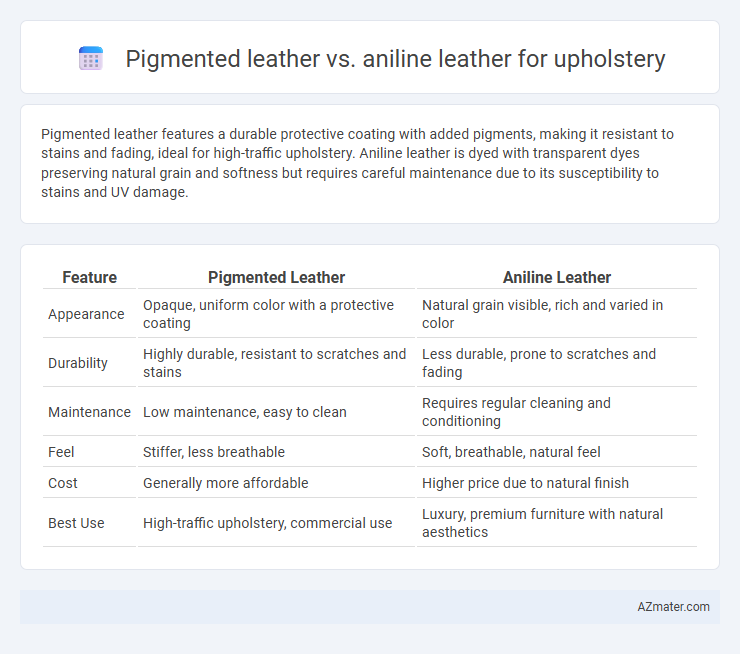Pigmented leather features a durable protective coating with added pigments, making it resistant to stains and fading, ideal for high-traffic upholstery. Aniline leather is dyed with transparent dyes preserving natural grain and softness but requires careful maintenance due to its susceptibility to stains and UV damage.
Table of Comparison
| Feature | Pigmented Leather | Aniline Leather |
|---|---|---|
| Appearance | Opaque, uniform color with a protective coating | Natural grain visible, rich and varied in color |
| Durability | Highly durable, resistant to scratches and stains | Less durable, prone to scratches and fading |
| Maintenance | Low maintenance, easy to clean | Requires regular cleaning and conditioning |
| Feel | Stiffer, less breathable | Soft, breathable, natural feel |
| Cost | Generally more affordable | Higher price due to natural finish |
| Best Use | High-traffic upholstery, commercial use | Luxury, premium furniture with natural aesthetics |
Understanding Pigmented Leather: Key Features
Pigmented leather for upholstery features a durable surface coating that enhances resistance to stains, fading, and wear, making it ideal for high-traffic areas. This type of leather typically has a uniform color and a slightly textured finish, providing consistent aesthetics and easy maintenance. Its protective pigment layer helps preserve leather quality over time, offering longevity and practical use in both residential and commercial furniture.
What is Aniline Leather? Characteristics and Qualities
Aniline leather is a high-quality upholstery material treated exclusively with soluble dyes, retaining the natural surface, including visible scars and pores, which highlights its depth and richness. Its characteristics include a soft, supple texture, excellent breathability, and a natural patina that develops over time, enhancing aesthetic appeal. This type of leather requires careful maintenance due to its susceptibility to stains and fading, distinguishing it from pigmented leather, which has a protective surface coating.
Durability Comparison: Pigmented vs Aniline Leather
Pigmented leather offers superior durability for upholstery due to its protective surface coating that resists scratches, stains, and fading, making it ideal for high-traffic areas. Aniline leather, while prized for its natural look and softness, lacks the protective pigmented layer and therefore is more susceptible to wear, discoloration, and staining over time. Choosing pigmented leather ensures longer-lasting upholstery with minimal maintenance, whereas aniline leather demands careful upkeep to preserve its appearance.
Appearance and Color Choices in Upholstery Leathers
Pigmented leather features a surface coating that masks natural imperfections, offering a uniform appearance and a broad range of vibrant color options ideal for upholstery that demands consistency. Aniline leather showcases a natural, untreated surface that allows the inherent grain and unique characteristics to shine through, resulting in a rich, varied patina over time with more limited but elegant color choices. The choice between pigmented and aniline leather for upholstery hinges on preference for either uniformity and extensive color palettes or natural beauty and subtle, classic shades.
Comfort and Feel: Which Leather Feels Better?
Pigmented leather offers a more consistent, smooth surface with a protective coating that enhances durability but can feel slightly stiffer and less breathable compared to aniline leather. Aniline leather, treated only with soluble dyes, retains the natural texture and softness of the hide, providing a luxurious, supple feel that improves with age and use. For upholstery prioritizing comfort and tactile appeal, aniline leather generally feels better due to its natural breathability and supple hand, although it requires more maintenance to preserve its delicate surface.
Stain and Spill Resistance: Practicality in Daily Use
Pigmented leather features a durable surface coating that provides excellent stain and spill resistance, making it highly practical for upholstery in high-traffic areas or homes with children and pets. Aniline leather, prized for its natural look and softness, has minimal protective treatment and readily absorbs liquids and stains, requiring more careful maintenance. For everyday use, pigmented leather offers superior practicality due to its ease of cleaning and resistance to spills, while aniline leather demands cautious handling to preserve its natural appearance.
Maintenance and Care Requirements
Pigmented leather features a durable protective coating that resists stains and fading, requiring only regular dusting and occasional mild soap cleaning to maintain its appearance. Aniline leather, lacking a protective surface layer, demands more careful upkeep including immediate spill cleaning and conditioning with specialized leather conditioners to prevent drying and fading. Choosing between pigmented and aniline leather for upholstery depends on desired maintenance effort and long-term durability needs.
Cost Differences Between Pigmented and Aniline Leather
Pigmented leather generally costs less than aniline leather due to its thicker protective coating and mass production process, offering durability at a lower price point. Aniline leather is more expensive because it undergoes minimal processing to maintain its natural appearance and softness, requiring higher-quality hides and careful finishing. The price gap reflects differences in material sourcing, treatment, and longevity suited for upholstery applications.
Environmental Impact and Sustainability Considerations
Pigmented leather features a durable surface coating that provides resistance to stains and UV exposure but involves synthetic chemicals impacting environmental sustainability negatively. Aniline leather is minimally treated with transparent dyes preserving the natural hide, offering biodegradability and lower chemical usage, which enhances its eco-friendly profile in upholstery applications. However, sourcing and tanning processes affect both types; vegetable tanning and responsible harvesting practices improve sustainability for both pigmented and aniline leather options.
Choosing the Right Leather for Your Upholstery Needs
Pigmented leather features a durable surface coating that resists stains, scratches, and fading, making it ideal for high-traffic upholstery in homes or commercial settings requiring easy maintenance. Aniline leather, prized for its natural look and soft texture, allows the leather's unique markings and grain to show through but demands careful protection from spills and sunlight exposure to preserve its appearance. Selecting between pigmented and aniline leather hinges on balancing aesthetic preferences with practical needs such as durability, cleaning ease, and the intended use environment for your upholstered furniture.

Infographic: Pigmented leather vs Aniline leather for Upholstery
 azmater.com
azmater.com